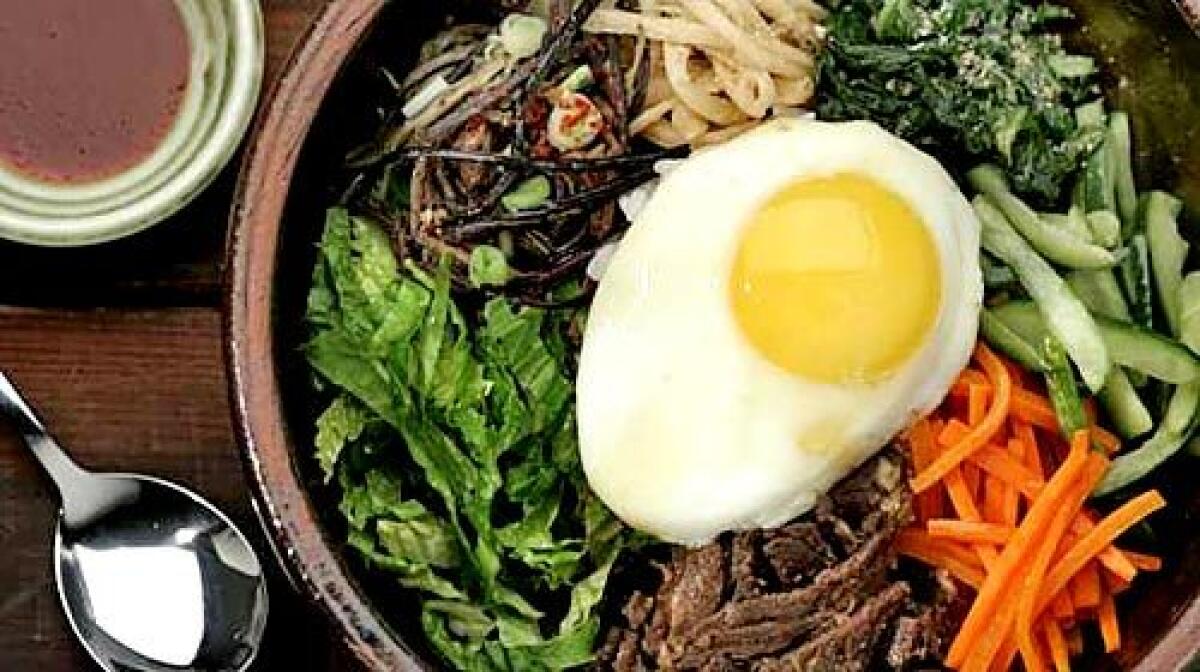Recipe: Bibimbap (Mixed rice)

Total time: 1 hour, 25 minutes
Servings: 4
Note: Kochujang, or Korean red-pepper paste, and thinly sliced beef can be found at Korean markets.
1/4 cup low-sodium soy sauce
2 tablespoons plus 2 teaspoons sesame oil, divided
1 1/2 tablespoons sugar, divided
2 cloves garlic, minced
1 teaspoon crushed roasted sesame seeds
1/4 teaspoon freshly ground black pepper
1 teaspoon finely minced ginger
1 pound thinly sliced rib-eye steak
2 cups short grain rice
1 cup julienned carrots (2 inches long)
1/2 cup red pepper paste (kochujang)
1/4 cup rice wine vinegar
4 eggs
1 cup toraji namul
1 cup spinach namul
1 cup cucumber namul
1 cup kosari namul
1 romaine lettuce heart, washed, dried and cut into thin strips (about 3 cups)
1. In a medium bowl, combine the soy sauce, 1 tablespoon sesame oil, 1 tablespoon sugar, the minced garlic, sesame seeds, black pepper and ginger. Mix well. Add the beef, cover, and marinate in the refrigerator for 30 minutes and up to overnight.
2. Heat the oven to 425 degrees. Place the beef in a thin layer on a greased roasting or baking pan and roast until browned, 10 to 15 minutes. Remove the pan from the oven and allow the meat to cool on the pan. When it’s cool enough to handle, slice into thin ribbons and set aside.
3. In a large pot, bring 2 1/2 cups of water to a boil. Add 2 cups rice, stirring. Cover and reduce the heat. Simmer for 20 minutes. Set aside.
4. In a large saucepan, heat 1 teaspoon of the sesame oil over medium-high heat and sauté the carrots until crisp-tender, about 5 minutes. (Unlike Chinese stir-frying, the Korean technique employs lower heat and a gentler cooking process -- no browning.) Set aside.
5. In a medium bowl, combine the red pepper paste, the remaining one-half tablespoon sugar, rice wine vinegar and one-fourth cup water. Mix well. Set aside.
6. Fry the eggs to sunny-side up in a large frying pan over medium heat, about 2 minutes per egg. Use just enough sesame oil to coat the pan to prevent the eggs from sticking.
7. Assemble each serving of bibimbap in four large individual bowls. Scoop three-fourths cup of rice in the center of each bowl. Add about one-fourth cup each of the toraji namul, the spinach namul, the kosari namul, the cucumber namul, the carrots, the beef and the romaine in small mounds on top of and around the rice. (Any leftover side dishes can be served along with the bowls, or refrigerate and serve them another time.) Top each bowl with one fried egg. Drizzle one teaspoon of sesame oil per bowl. Serve with a side of red pepper paste. When ready to eat, add the pepper paste and vigorously mix all the ingredients with a spoon, the traditional utensil for bibimbap.
Each serving: 903 calories; 39 grams protein; 103 grams carbohydrates; 10 grams fiber; 37 grams fat; 11 grams saturated fat; 283 mg. cholesterol; 1,901 mg. sodium.
More to Read
Sign up for our L.A. Times Plants newsletter
At the start of each month, get a roundup of upcoming plant-related activities and events in Southern California, along with links to tips and articles you may have missed.
You may occasionally receive promotional content from the Los Angeles Times.






